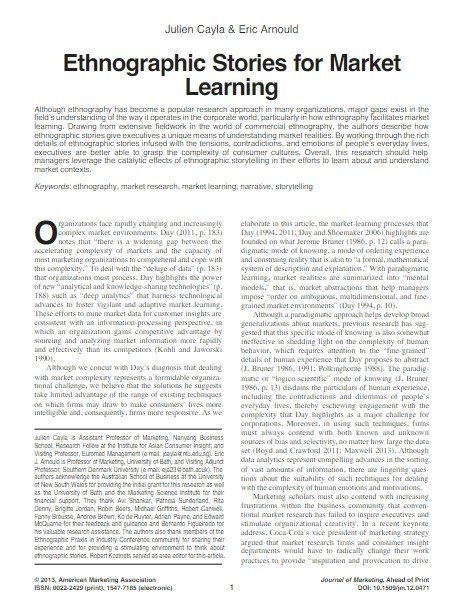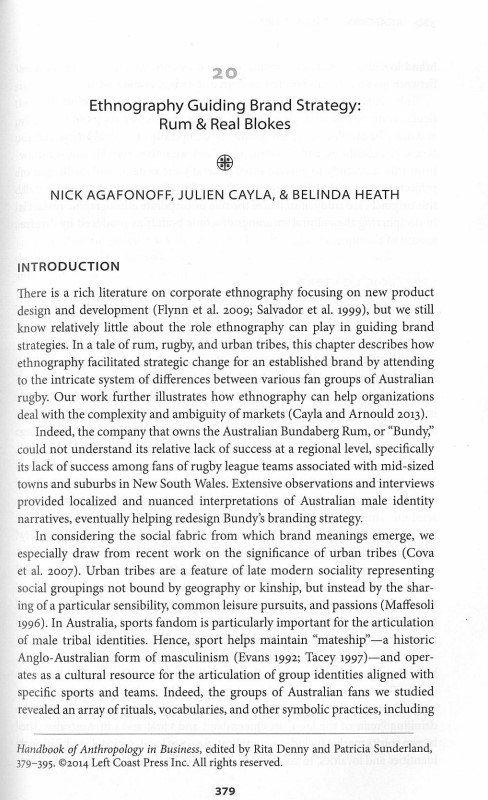Ethnography

Abstract Although ethnography has become a popular research approach in many organizations, major gaps exist in the field's understanding of the way it operates in the corporate world, particularly in how ethnography facilitates market learning. Drawing from extensive fieldwork in the world of commercial ethnography, the authors describe how ethnographic stories give executives a unique means of understanding market realities. By working through the rich details of ethnographic stories infused with the tensions, contradictions, and emotions of people's everyday lives, executives are better able to grasp the complexity of consumer cultures. Overall, this research should help managers leverage the catalytic effects of ethnographic storytelling in their efforts to learn about and understand market contexts
Cayla, Julien & Arnould, Eric. (2013). Ethnographic Stories for Market Learning. Journal of Marketing, 77. 1-16

Arnould, E.J., & Cayla, J. (2015). Consumer Fetish: Commercial Ethnography and the Sovereign Consumer. Organization Studies, 36, 1361 - 1386.
Abstract: What is the sovereign consumer that occupies such a central role in organizational discourse whosesatisfaction has become an organizational imperative? Our research draws from extended fieldwork in theworld of commercial ethnography. Our analysis shows how ethnography is implicated in the organizationalfetishization of consumers, that is, how in the process of understanding and managing markets, a quasi-magical fascination with amalgams of consumer voices, images, and artefacts comes about. We offer severalcontributions. First, we demonstrate the pertinence of (primarily anthropological) theories of the fetish toorganizational sensemaking. Second, we describe a distinctive process of organizational market sensemakingthat is sensuous, magical, and analogical. Third, we offer a subtle critique of commercial ethnography, apopular research practice that aims to bring ‘real’ consumers to life inside the firm.

Arnould, Eric & Cayla, Julien & Dion, Delphine. (2017). Fetish, magic, marketing. Anthropology Today. 33. 28-32.
Abstract This article identifies specific forms of fetishistic enchantments produced by practices culturally specific to modern consumer culture. The authors show that magical practices are constitutive of two fetishistic marketing constructs: the consumer and the human luxury brand. Marketing magic enacts relations between man and the transcendent by bringing consumer personas ‘to life’ and manifesting ideals of the beautiful in luxury. Marketing magic is a practice of power – non-rationalist strategies for resolving intractable social problems. Consumer ‘personas’ create manageable consumer interlocutors for companies. Charismatic creative directors seem to evade the iron logic of commodity relationships via the magical conjuring of their own personas and of artful luxury.

Cayla, Julien, Arnould, Eric and Robin Beers (2014), “Stories that Deliver Business Insights,” MIT Sloan Management Review, vol. 55 (2), 55–62.
Ethnographic stories offer executives an empathic understanding of how consumers live, work and play through gritty and detailed descriptions. What you learn from ethnographic stories may surprise you — and change your company’s strategy.

Agafonoff, Nick, Cayla, Julien and Heath, Belinda (2014), “Ethnography Guiding: Brand Strategy: Rum & Real Blokes,” in eds. R. Denny and P. Sunderland, An Anthropological Sourcebook, Left Coast Press, pp. 379–395.

Zwick, Detlev & Cayla, Julien eds. (2011). Inside Marketing: Practices, Ideologies, Devices. Oxford University Press.
Abstract In comparison to the impressive amount of resources, time, and energy going into researching the inner life of consumers, a rather minor effort has been made to study the growing army of economic actors whose work it is to define markets and give shape to the consumer culture as we know it. Furthermore, the results of the work that marketers do are, by definition, highly visible. Indeed, we would suggest that making things visible (in the sense of bringing forward and rendering meaningful and recognizable) through, for example, product design, packaging, display strategies, commercial architecture, branding, advertising, and promotional activities is the raison d'être of marketing. Yet, the visibility of marketing activities contrasts with the relative obscurity of the inner workings of the marketing profession. Indeed, little scholarly work has been directed at investigating the practices, ideologies, and devices of marketing professionals and how "marketing work" is enacted in organizational contexts. This book brings together leading social scientists and business scholars to deliver a systematic attempt to theorize contemporary marketing from the inside out.





